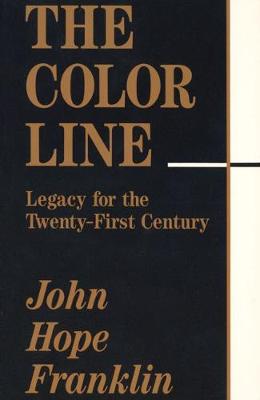Paul Anthony Brick Lectures
1 total work
"The problem of the 20th century will be the problem of the colour line - the relation of the darker to the lighter races of men", wrote author and civil rights leader W.E.D. Du Bois in 1903. As the 20th century comes to a close, one of America's most distinguished historians takes an unflinching look at race relations in America today. Distilling more than two centuries of history, John Hope Franklin reflects on the most tragic and persistent social problem in the American nation's history - the colour line - as it becomes the legacy for the next century. "The Color Line" originated as three lectures delivered at the University of Missouri - Columbia in April 1992, just one day after the "not guilty" verdict was returned in the trial of Los Angeles police officers in the beating of Rodney King. The violence that shook Los Angeles and soon erupted in other cities across the country provided a dramatic backdrop for Franklin's message: the colour line holds fast - in education, in housing, in health care, and in the legal system. Franklin illuminates some of the key episodes in the nation's history.
He traces America's forward and backward steps on the path toward racial equality, from the Carter administration's record number of appointments of African Americans to the bench, to the Reagan administration's effort to continue support for educational institutions that persisted in racial discrimination and segregation. Examining the historical role of race in both the Republican and Democratic parties, Franklin argues that while opponents of affirmative action claim to promote a colour-blind legal system, many have adopted race-encoded rhetoric to raise the spectre of racial fear and hatred. Franklin also outlines the questionable civil rights record of Clarence Thomas, whose nomination and confirmation as Supreme Court justice provoked considerable controversy among civil rights leaders. The colour line continues to flourish in the final decade of the 20th century. "Perhaps the very first thing we need to do as a nation and as individual members of society", writes Franklin, "is to confront our past and see it for what it is".
He traces America's forward and backward steps on the path toward racial equality, from the Carter administration's record number of appointments of African Americans to the bench, to the Reagan administration's effort to continue support for educational institutions that persisted in racial discrimination and segregation. Examining the historical role of race in both the Republican and Democratic parties, Franklin argues that while opponents of affirmative action claim to promote a colour-blind legal system, many have adopted race-encoded rhetoric to raise the spectre of racial fear and hatred. Franklin also outlines the questionable civil rights record of Clarence Thomas, whose nomination and confirmation as Supreme Court justice provoked considerable controversy among civil rights leaders. The colour line continues to flourish in the final decade of the 20th century. "Perhaps the very first thing we need to do as a nation and as individual members of society", writes Franklin, "is to confront our past and see it for what it is".
